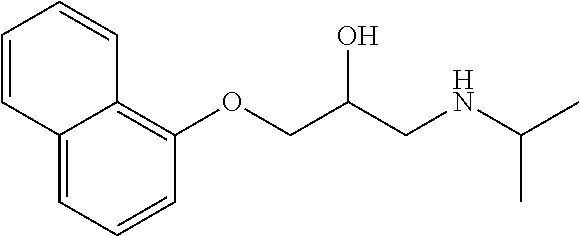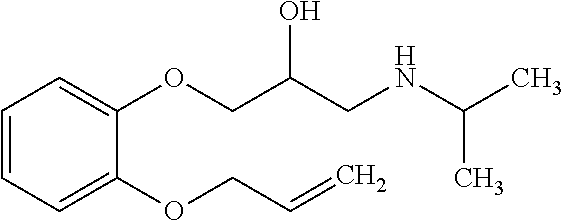Treatment of infantile hemangioma
a technology of beta blockers and infantile hemangioma, which is applied in the direction of heterocyclic compound active ingredients, drug compositions, plant/algae/fungi/lichens ingredients, etc., can solve the problems of rarely used corticosteroids, permanent scarring and disfiguremen
- Summary
- Abstract
- Description
- Claims
- Application Information
AI Technical Summary
Benefits of technology
Problems solved by technology
Method used
Image
Examples
example 1
Solubility of Esmolol in Various Solvents
[0047]Knowing the solubility of a drug in different excipients and chemical enhancers is important in optimizing the saturation solubility of the drug in topical and transdermal formulations. Here below is a table (Table 1) showing the solubility of esmolol in several excipients and chemical enhancers. The solubility of Esmolol was higher in hydrophilic excipients and lower in the more lipophilic excipients. Several of these compounds were used to prepare the formulations in Example 2, such as the co-enhancing system of oleyl alcohol and propylene glycol.
TABLE 1Esmolol Solubility in Various ExcipientsSat. Conc. Solvent(mg / mL)Propylene Glycol450.7PEG-400248.6DMSO592.1Dipropylene Glycol257.6Oleyl Alcohol112.2Transcutol P344.5Ethanol310.4Water704.1Isopropyl myristate (IPM)196.2Castor Oil (CO)23.4Cotton seed oil (CSO)101.9Olive Oil (OO)58.1Sesame oil (SO)56.6Glyceryl monooleate (GMO)157.3Lauroglycol FCC (LG)122.2Oleic acid (OA)56.9
example 2
In Vitro Enhanced Skin Permeation of Esmolol
[0048]One skin donor and three diffusion cells per formulation were used in these in vitro skin permeation experiments. Split thickness dermatomed (approximately at 375 μm) human cadaver skin was used to determine the permeation rate of the beta blocker Esmolol in vitro. All in vitro skin permeation studies were conducted using the PermeGear Membrane Transport System. Each Membrane Transport System consists of vertical, jacketed (37° C.±0.5° C.) Franz diffusion cells with magnetic stirrer and 1.7 cm2 diffusion area.
[0049]Skin flux studies were run for a period of 24 hours. At predetermined intervals after starting the experiment, the entire contents of the receiver compartment were collected for determination of the Esmolol concentration by HPLC. The receiver compartment was refilled with fresh receiver medium. The receiver medium was pH 7.4 water with 0.44 mg / ml of Oleath 20 with the saturation concentration of the drug in the receptor me...
example 3
Skin Permeation of Esmolol from Gels with and without an Esterase Inhibitor
[0053]One skin donor and three diffusion cells per formulation are used in these in vitro skin permeation experiments. The experiment was performed using the same instruments and methodologies as described in Example 2. Two formulations are used: C, which is the same as ES-1, and D, which is the same as ES-1 but modified by addition of 1% each of the esterase inhibitors myristic acid and castor oil. The skin permeation experiment is performed for 24 hours and the flux is obtained in micrograms per cm2 per hour for the two formulations.
PUM
| Property | Measurement | Unit |
|---|---|---|
| concentrations | aaaaa | aaaaa |
| thickness | aaaaa | aaaaa |
| diffusion area | aaaaa | aaaaa |
Abstract
Description
Claims
Application Information
 Login to View More
Login to View More - R&D
- Intellectual Property
- Life Sciences
- Materials
- Tech Scout
- Unparalleled Data Quality
- Higher Quality Content
- 60% Fewer Hallucinations
Browse by: Latest US Patents, China's latest patents, Technical Efficacy Thesaurus, Application Domain, Technology Topic, Popular Technical Reports.
© 2025 PatSnap. All rights reserved.Legal|Privacy policy|Modern Slavery Act Transparency Statement|Sitemap|About US| Contact US: help@patsnap.com



